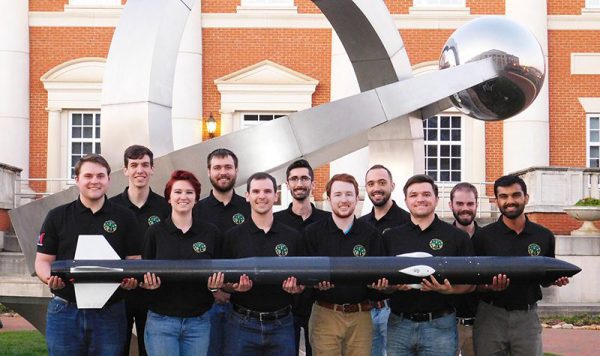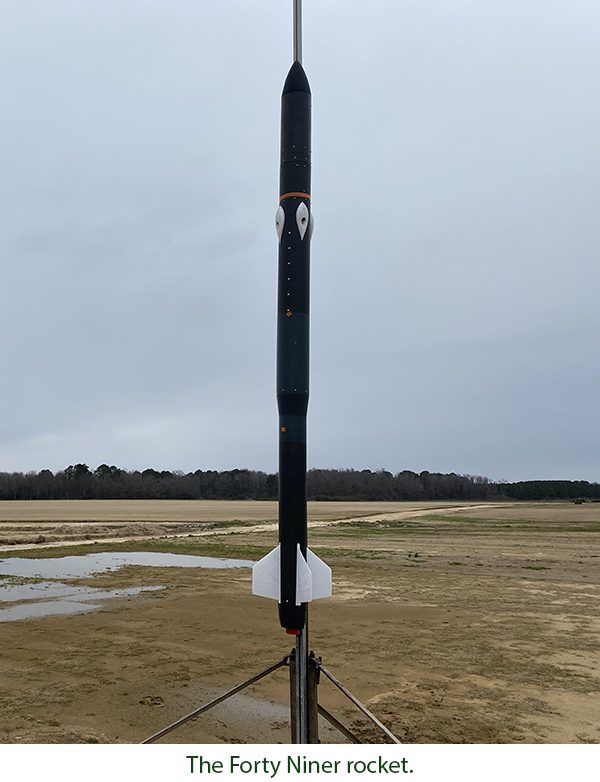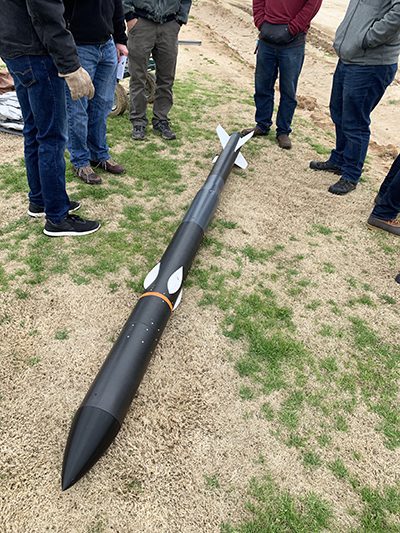Niner Rocketry Team Places 2nd Overall in NASA Event

Although the program was delayed and the annual launch finale event in Huntsville cancelled, 54 teams were able to compete remotely in the design, building and testing portions of the 2020 NASA Student Launch competition, and the UNC Charlotte Rocketry team finished second overall, and first in the payload portion of the event.
The 2020 NASA competition required college and university teams to design and build rocket and payload systems that would launch to a specified altitude, then during decent of after landing deploy a vehicle that would navigate to a designated sample site, retrieve a simulated sample of planetary ice, and navigate at least 10 feet away from the site with the sample stored safely aboard.
In late July, NASA announced virtually the overall and category winners of the competition. The top overall teams were Vanderbilt University, UNC Charlotte, and the University of Alabama Huntsville.
The Forty Niner team was made up of Lee College of Engineering undergraduates from mechanical, systems, electrical and computer engineering, and mechanical engineering technology. The team members were Tyler Ainsworth, David Black, David Clifton, Dan Cornett, Alex Dechant, Aryan Gupta, Samantha McKinney, Jacen Mott, Max Peterson, Gunner Petrea, Jackson Smith and Tyler Watkins. The team’s faculty mentor was Dr. Jerry Dahlberg of the Mechanical Engineering Department.
“This year’s teams showed true innovation and determination as they tackled the new payload challenge and the unconventional methods we had to employ to complete the competition,” said Fred Kepner, an education program specialist and lead for Student Launch at NASA’s Marshall Space Flight Center. “Despite the unique obstacles they faced this year, their commitment to technical excellence and carrying on in the spirit of the competition never wavered.”
Teams earned points for progress and successes during the eight-month competition. Awards were presented in multiple categories including payload design, safety, best social media presence and STEM outreach.

The UNC Charlotte team won the Best Payload Design award. The Forty Niner payload was a two-part system, with the first part detecting the sample retrieval area during the rocket’s decent. The information was then relayed to an unmanned aerial vehicle, which using integrated computer vision and obstacle avoidance navigated to the retrieval area, collected the simulated lunar ice, then moved at least 10 feet away from that site with the sample safely stored.
In the Best Vehicle Design category, the UNC Charlotte team placed third. The category scores teams for the most creative, innovative and well-constructed rocket design for carrying the payload, while maximizing safety and efficiency.
UNC Charlotte also placed third in the Safety Award category, which is given to teams who meet all safety expectations and have the highest-quality documentation of safety designs and procedures.
A statement from the Forty Niner Rocketry team about the 2019-2020 NASA Student Launch Competition is below:
“The results are in. We are very proud to say we placed second this year. The competition was very stiff and the project was challenging. We would like to thank everyone who supported us this year, especially NASA / North Carolina Space Grant and the UNC Charlotte College of Engineering. We would also like to thank the people who put this challenge together every year at NASA.
“Congratulations to all of the teams that competed this year. We can’t wait to meet face to face in Huntsville next year (hopefully).
“For the 19-20 challenge, the team needed to design, build and test a system capable of being launched in a high-power rocket, landing safely, and recovering simulated lunar ice from one of several locations on the surface of the launch field. The method of ice recovery was at the team’s discretion. Additionally, the team needed to select a final altitude between 3,500-5,500 feet above ground level.
“UNC Charlotte chose to approach the design challenge by designing and building a UAV that was retained inside the rocket during launch. Depending on launch conditions on the day of the flight, the team had built in two different deployment methods. The first was to eject the UAV while the rocket was still 400 feet above ground level. This option required the launch safety officer to give the team approval to begin deployment. Once ejected, the UAV would autonomously travel to the lunar ice location, land, recover a sample and fly to a distance 10 feet away from where the sample was recovered. The second option was to wait until the rocket had landed. Once the rocket landed, the UAV was deployed and autonomously traveled to the lunar ice location. To help locate the lunar ice location, a secondary payload that consisted of an onboard camera vision system was designed to locate the ice while the rocket was in vertical flight and report the locations on the field to the UAV.

“It was very challenging this year to work around all of the restrictions put in place. The NASA student launch team worked very hard to give the students the best possible experience given the situation. Although it was disappointing not to go to Huntsville to compete, the overall experience was great and the team learned a lot. Throughout the two-semester project, the team grew and learned to work well together and developed plans to complete all of the testing, even after we were not allowed to return to campus. From beginning to end, the team built a subscale rocket, which was flown four times, and the full-scale rocket which was flown twice. The team also completed the UAV and deployment systems, which were rigorously tested and met all mission requirements. We are very proud of our first place in payload design, third place in vehicle design and second-place finish overall.
More information about NASA’s Student Launch is here.